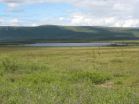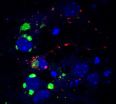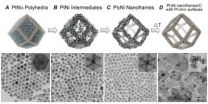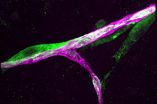(Press-News.org) A new study led by the University of Colorado Boulder bolsters the theory that the first Americans, who are believed to have come over from northeast Asia during the last ice age, may have been isolated on the Bering Land Bridge for thousands of years before spreading throughout the Americas.
The theory, now known as the "Beringia Standstill," was first proposed in 1997 by two Latin American geneticists and refined in 2007 by a team led by the University of Tartu in Estonia that sampled mitrochondrial DNA from more than 600 Native Americans. The researchers found that mutations in the DNA indicated a group of their direct ancestors from Siberia was likely isolated for at least several thousand years in the region of the Bering Land Bridge, the now-submerged plain that lies between northeast Asia and Alaska once exposed by a significantly lower sea level.
CU-Boulder researcher John Hoffecker, lead author of a short paper article appearing in the Feb. 28 issue of Science magazine, said the Beringia Standstill model gained little traction outside of the genetics community after it was proposed and has been seen by some scientists outside of the field as far-fetched. But the new paper by Hoffecker and co-authors Scott Elias of Royal Holloway, University of London, and Dennis O'Rourke of the University of Utah adds credence to the Beringia Standstill idea by further linking the genetics to the paleoecological evidence.
"A number of supporting pieces have fallen in place during the last decade, including new evidence that central Beringia supported a shrub tundra region with some trees during the last glacial maximum and was characterized by surprisingly mild temperatures, given the high latitude," said Hoffecker of CU-Boulder's Institute of Arctic and Alpine Research. The last glacial maximum peaked roughly 21,000 years ago and was marked by the growth of vast ice sheets in North America and Europe.
While a debate rages on about when early humans first migrated into the New World, many archaeologists now believe it was sometime around 15,000 years ago after retreating glaciers opened access to coastal and interior routes into North America.
The relatively mild summer climate in Beringia at the time was caused by North Pacific circulation patterns that brought moist and relatively warm air to the region during the last glacial maximum. Geologists believe the Beringia gateway between Siberia and Alaska was more than 600 miles wide at the time.
Hoffecker and others are now theorizing that a population of hundreds or thousands of people parked itself in central Beringia for 5,000 years or more. One key to the extended occupation may have been the presence of wood in some places to use as a fuel to supplement bone, which burns hot and fast. Experiments have shown that at least some wood is necessary to make bone practical as a fuel.
Elias, a paleoecologist and also an INSTAAR affiliate, said research using fossil pollen, plant and insect material from sediment cores from the now submerged landscape show that the Bering Land Bridge tundra environment contained enough woody plants and trees like birch, willow and alder to provide a supplement to bone.
Work by Elias and others included the analysis of certain beetle species that live in very specific temperature zones, allowing them to be used as tiny thermometers. The insects indicated that temperatures there were relatively mild during last glacial maximum that ran from about 27,000 years to 20,000 years ago, only slightly cooler than temperatures in the region today.
"The climate on the land bridge and adjacent parts of Siberia and Alaska was a bit wetter than the interior regions like central Alaska and the Yukon, but not a lot warmer," said Elias. "Our data show that woody shrubs were available on the land bridge, which would have facilitated the making of fires by the people there."
Evidence from the 2007 study indicated a set of genetic mutations in mitochondrial DNA, which is passed down from mother to offspring, clearly accumulated after the divergence of people from their Asian parent groups in Siberia but before their dispersal throughout the Western Hemisphere, said O'Rourke. In addition, ancient DNA from human skeletal remains found at a 24,000-year-old archaeological site in southern Siberia also appears consistent with the divergence of Native American groups from their Asian forbearers by that time window, he said.
"The genetic record has been very clear for several years that the Native American genome must have arisen in an isolated population at least by 25,000 years ago, and the bulk of the migrants to the Americas really didn't arrive south of the ice sheets until nearly 15,000 years ago," O'Rourke said. "The paleoecological data, which I think most geneticists have not been familiar with, indicate that Beringia was not a uniform environment, and there was a shrub tundra region, or refugium, that likely provided habitats conducive to continuous human habitation."
"From my view the genetics and paleoecology data come together nicely," said Hoffecker, who co-authored a 2007 book with Elias titled "The Human Ecology of Beringia." While the weakest link to the Out of Beringia theory is the lack of archaeological evidence, Hoffecker believes future research on now submerged parts of Beringia as well as lowlands in western Alaska and eastern Siberia that still remain above water may hold clues to ancient habitation by Beringia residents, who eventually moved on to be the first group to inhabit the Americas.
Hoffecker also believes that the Beringia inhabitants during the last glacial maximum could have made successful hunting forays into the uninhabited steppe-tundra region to both the east and west, where drier conditions and more grass supported a plentiful array of large grazing animals, including steppe bison, horse and mammoth.
There is now solid evidence for humans in Beringia before the last glacial maximum, as geneticists first predicted in 1997, said Hoffecker. After the maximum, there are two sets of archaeological remains dating to less than 15,000 years ago. "One represents a late migration from Asia into Alaska at that time," he said. "The other has no obvious source outside Beringia and may represent the people who are thought to have sheltered on the land bridge during the glacial maximum.
"If we are looking for a place to put all of these people during the last glacial maximum, Beringia may be the only realistic option," said Hoffecker.
INFORMATION:
A video news story on the research is available at http://www.colorado.edu/news.
Contact:
John Hoffecker, 303-220-7646
john.hoffecker@colorado.edu
Jim Scott, CU-Boulder media relations, 303-492-3114
jim.scott@colorado.edu
CU-led study says Bering Land Bridge a long-term refuge for early Americans
Population of hundreds or thousands likely lived on land bridge for up to 10,000 years
2014-02-27
ELSE PRESS RELEASES FROM THIS DATE:
Fossils offer new clues into Native American's 'journey' and how they survived the last Ice Age
2014-02-27
Researchers have discovered how Native Americans may have survived the last Ice Age after splitting from their Asian relatives 25,000 years ago.
Academics at Royal Holloway, University of London, and the Universities of Colorado and Utah have analysed fossils which revealed that the ancestors of Native Americans may have set up home in a region between Siberia and Alaska which contained woody plants that they could use to make fires. The discovery breaks new ground as until now no-one had any idea of where the native Americans spent the next 10,000 years before they appeared ...
Researchers reveal the dual role of brain glycogen
2014-02-27
In 2007, in an article published in Nature Neuroscience, scientists at the Institute for Research in Biomedicine (IRB Barcelona) headed by Joan Guinovart, an authority on glycogen metabolism, reported that in Lafora Disease (LD), a rare and fatal neurodegenerative condition that affects adolescents, neurons die as a result of the accumulation of glycogen—chains of glucose. They went on to propose that this accumulation is the root cause of this disease.
The breakthrough of this paper was two-sided: first, the researchers established a possible cause of LD and therefore ...
UCSB study reveals evolution at work
2014-02-27
New research by UC Santa Barbara's Kenneth S. Kosik, Harriman Professor of Neuroscience, reveals some very unique evolutionary innovations in the primate brain.
In a study published online today in the journal Neuron, Kosik and colleagues describe the role of microRNAs — so named because they contain only 22 nucleotides — in a portion of the brain called the outer subventricular zone (OSVZ). These microRNAs belong to a special category of noncoding genes, which prevent the formation of proteins.
"It's microRNAs that provide the wiring diagram, dictating which genes ...
Big step for next-generation fuel cells and electrolyzers
2014-02-27
A big step in the development of next-generation fuel cells and water-alkali electrolyzers has been achieved with the discovery of a new class of bimetallic nanocatalysts that are an order of magnitude higher in activity than the target set by the U.S. Department of Energy (DOE) for 2017. The new catalysts, hollow polyhedral nanoframes of platinum and nickel, feature a three-dimensional catalytic surface activity that makes them significantly more efficient and far less expensive than the best platinum catalysts used in today's fuel cells and alkaline electrolyzers. This ...
Fossilized human feces from 14th century contain antibiotic resistance genes
2014-02-27
A team of French investigators has discovered viruses containing genes for antibiotic resistance in a fossilized fecal sample from 14th century Belgium, long before antibiotics were used in medicine. They publish their findings ahead of print in the journal Applied and Environmental Microbiology.
"This is the first paper to analyze an ancient DNA viral metagenome," says Rebecca Vega Thurber of Oregon State University, Corvallis, who was not involved in the research.
The viruses in the fecal sample are phages, which are viruses that infect bacteria, rather than infecting ...
Physicians' stethoscopes more contaminated than palms of their hands
2014-02-27
VIDEO:
A comparative analysis shows that stethoscope diaphragms are more contaminated than the physician's own thenar eminence (group of muscles in the palm of the hand) following a physical examination.
Click here for more information.
Rochester, MN, February 27, 2014 – Although healthcare workers' hands are the main source of bacterial transmission in hospitals, physicians' stethoscopes appear to play a role. To explore this question, investigators at the University of ...
Study reveals mechanisms cancer cells use to establish metastatic brain tumors
2014-02-27
NEW YORK, NY, February 27, 2014 — New research from Memorial Sloan Kettering provides fresh insight into the biologic mechanisms that individual cancer cells use to metastasize to the brain. Published in the February 27 issue of Cell, the study found that tumor cells that reach the brain — and successfully grow into new tumors — hug capillaries and express specific proteins that overcome the brain's natural defense against metastatic invasion.
Metastasis, the process that allows some cancer cells to break off from their tumor of origin and take root in a different tissue, ...
Methane leaks from palm oil wastewater are a climate concern, CU-Boulder study says
2014-02-27
In recent years, palm oil production has come under fire from environmentalists concerned about the deforestation of land in the tropics to make way for new palm plantations. Now there is a new reason to be concerned about palm oil's environmental impact, according to researchers at the University of Colorado Boulder.
An analysis published Feb. 26 in the journal Nature Climate Change shows that the wastewater produced during the processing of palm oil is a significant source of heat-trapping methane in the atmosphere. But the researchers also present a possible solution: ...
Famed Milwaukee County Zoo orangutan's death caused by strange infection
2014-02-27
MADISON – Mahal, the young orangutan who became a star of the Milwaukee County Zoo and an emblem of survival for a dwindling species, led an extraordinary life.
It turns out, the young ape died an extraordinary death, too.
Rejected by his biological mother at the Cheyenne Mountain Zoo in Colorado Springs, Colo., and eventually flown to Milwaukee aboard a private jet to live with a surrogate mother, Mahal became one of the Milwaukee County Zoo's star attractions. His unexpected death at age 5 in late December 2012 was a shock to the community that came to know him through ...
Scientists describe deadly immune 'storm' caused by emergent flu infections
2014-02-27
LA JOLLA, CA—February 26, 2014—Scientists at The Scripps Research Institute (TSRI) have mapped key elements of a severe immune overreaction—a "cytokine storm"—that can both sicken and kill patients who are infected with certain strains of flu virus.
Their findings, published in this week's online Early Edition of the Proceedings of the National Academy of Sciences, also clarify the workings of a potent new class of anti-inflammatory compounds that prevent this immune overreaction in animal models.
"We show that with this type of drug, we can quiet the storm enough to ...
LAST 30 PRESS RELEASES:
Making lighter work of calculating fluid and heat flow
Normalizing blood sugar can halve heart attack risk
Lowering blood sugar cuts heart attack risk in people with prediabetes
Study links genetic variants to risk of blinding eye disease in premature infants
Non-opioid ‘pain sponge’ therapy halts cartilage degeneration and relieves chronic pain
AI can pick up cultural values by mimicking how kids learn
China’s ecological redlines offer fast track to 30 x 30 global conservation goal
Invisible indoor threats: emerging household contaminants and their growing risks to human health
Adding antibody treatment to chemo boosts outcomes for children with rare cancer
Germline pathogenic variants among women without a history of breast cancer
Tanning beds triple melanoma risk, potentially causing broad DNA damage
Unique bond identified as key to viral infection speed
Indoor tanning makes youthful skin much older on a genetic level
Mouse model sheds new light on the causes and potential solutions to human GI problems linked to muscular dystrophy
The Journal of Nuclear Medicine ahead-of-print tip sheet: December 12, 2025
Smarter tools for peering into the microscopic world
Applications open for funding to conduct research in the Kinsey Institute archives
Global measure underestimates the severity of food insecurity
Child survivors of critical illness are missing out on timely follow up care
Risk-based vs annual breast cancer screening / the WISDOM randomized clinical trial
University of Toronto launches Electric Vehicle Innovation Ontario to accelerate advanced EV technologies and build Canada’s innovation advantage
Early relapse predicts poor outcomes in aggressive blood cancer
American College of Lifestyle Medicine applauds two CMS models aligned with lifestyle medicine practice and reimbursement
Clinical trial finds cannabis use not a barrier to quitting nicotine vaping
Supplemental nutrition assistance program policies and food insecurity
Switching immune cells to “night mode” could limit damage after a heart attack, study suggests
URI-based Global RIghts Project report spotlights continued troubling trends in worldwide inhumane treatment
Neutrophils are less aggressive at night, explaining why nighttime heart attacks cause less damage than daytime events
Menopausal hormone therapy may not pose breast cancer risk for women with BRCA mutations
Mobile health tool may improve quality of life for adolescent and young adult breast cancer survivors
[Press-News.org] CU-led study says Bering Land Bridge a long-term refuge for early AmericansPopulation of hundreds or thousands likely lived on land bridge for up to 10,000 years





